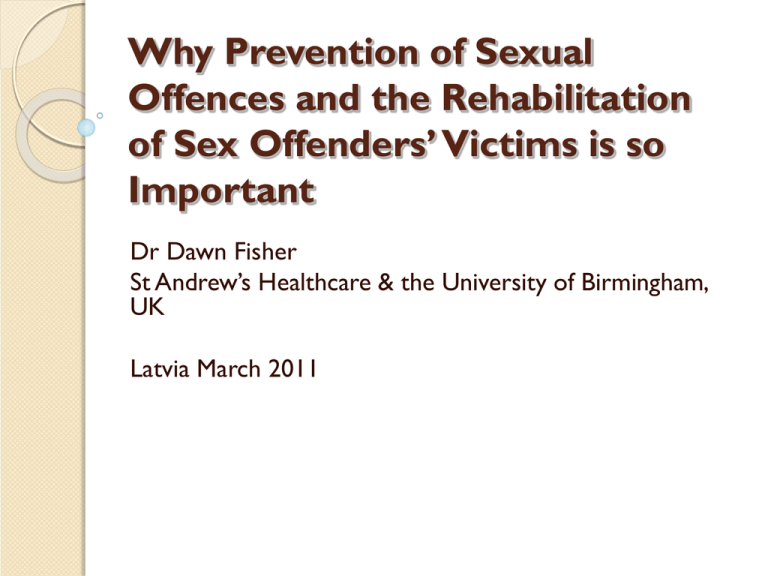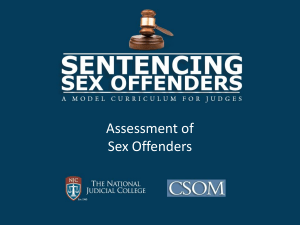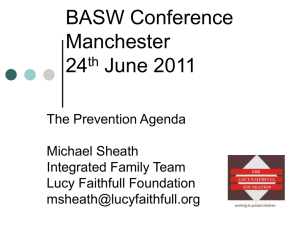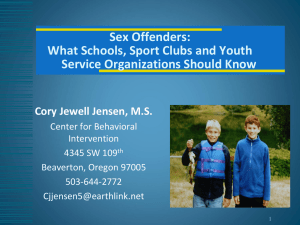
Why Prevention of Sexual
Offences and the Rehabilitation
of Sex Offenders’ Victims is so
Important
Dr Dawn Fisher
St Andrew’s Healthcare & the University of Birmingham,
UK
Latvia March 2011
How many sex offenders are there?
As of September 2010 87,628 individuals in
prison
With around 8000+ sexual offenders in prison
(9%)
Similar number of rapists and child abusers in
prison
Underestimate of real level of sexual offending
UG sex offender theories 2010
2
Prevalence
There are problems in ascertaining the actual level of
sexual offending
The primary difficulty being that only a small fraction of
sexual offences are ever reported. Generally speaking,
the more serious the type of offence and the more
distant the relationship between victim and offender, the
more likely the offence is to be reported (Myhill & Allen,
2002)
UG sex offender theories 2010
3
Bias
Hence, there is a bias towards the reporting of what might
be considered the fixated paedophilic, offences compared
to, incestuous sexual offences or stranger rapes compared
to date rape
Prentky and Burgess (2000) also note that underreporting
tends to be greater when offences are carried out against
males rather than against females, whether the victims are
children, teenagers or adults
In addition to under-reporting of sexual offences, there is
also the problem of sexual offences being difficult to
prosecute satisfactorily and result in a conviction
UG sex offender theories 2010
4
Difficulty in obtaining
convictions
◦ The nature of sexual offending often means that it is typically
the victim’s word against the perpetrators with no
corroborating evidence
◦ Here, there are often problems in using children as witnesses
and adult victims may retract their statements due to fear or
pressure from others
◦ Thus, relying on conviction figures and the number of men in
prison or on probation for sexual offences at a given time, is
likely to result in a gross underestimation of the true level of
sexual offending against children and adults
UG sex offender theories 2010
5
Prevalence of sexual abuse
Methods of detection
- Prevalence surveys - based on selfreport
Allegations and Convictions
Information from sexual offenders – Abel et al.
survey
Number of psychiatric patients with sexual abuse
histories
Prevalence of child abuse
Victim survey data suggests that the prevalence of sexual offences against
children is alarming
Probably the latest study in the U.K. (Cawson, Wattam, Brooker, & Kelly,
2000) found that 16% of girls and 7% of boys have been sexually
assaulted before the age of 13
More than twice the number reported that they had been abused by
somebody they knew (parents or carers, other relatives, or by other known
people) than had been abused by a stranger or by someone that they had
just met
These results indicate that it is much more likely that a child will be
abused by somebody they know
UG sex offender theories 2010
7
Gender of perpetrator of CSA
Most known child abuse offences would appear to be committed by
males
However, the reported rate of female offending may be a severe
underestimation of the number of offences actually committed by
women/ adolescent females
Current criminal statistics in the U.K. indicate that around 99% of
convicted sexual offenders are male and 1% offenders are female
However, the l figures from Childline (A telephone helpline in the U.K.
for those who are being abused or know about individuals who are
being abused) for April 2002 – March 2003, suggest that the female
perpetrator figures are actually far higher than the official conviction
figures reveal
UG sex offender theories 2010
8
Level of female perpetrators of
CSA
According to ChildLine, the overall percentage of those
calling about being abused by a female perpetrator has
risen by 132% in the last five years
As for actual rates in 2008 ChildLine counsellors heard
from 8765 children
◦ 2142 children who had been abused by a female (about 25%)
◦ 6623 reported they had abused by a female
UG sex offender theories 2010
9
Prevalence of rape
Myhill and Allen in 2002 reported a study of the level of
adult sexual victimization in a sample of nearly 7000
women aged 16 to 59 in the U.K
They found that nearly 10% reported some form of sexual
victimization, since the age of 16, with half of the assaults
being rape
The level of physical injury in these attacks was found to
be extremely high with 74% of women who had been
raped reported the use of physical force or violence
◦ 37% of these attacks resulting in physical injury
◦ 10% causing ‘severe’ injury, such as broken bones
UG sex offender theories 2010
10
Effects of child abuse
As for its effect upon victims, sexual abuse has
been related to a number of negative behavioral
outcomes in children, such as fear, nightmares,
regressive/withdrawn behavior, cruelty,
delinquency, , running away, poor self-esteem,
general behavior problems, and sexually
inappropriate behavior ((Beitchman, et al., 1991;
Kendall-Tackett, Williams, & Finkelhor, 1993)
Children reporting sexual abuse involving
intercourse, compared with non-abused children,
had an increased incidence of major depression
and suicide attempts (Fergusson, Horwood, &
Lynskey, 1996; Fergusson, Lynskey, & Horwood,
1996)
Effects of child abuse 2
A variety of adult psychiatric conditions arising
from child sexual abuse have also been reported
including anxiety and acute stress disorders,
bulimia nervosa, depression, dissociative identity
disorder, personality disorders (such Borderline
Personality Disorder), Post Traumatic Disorder,
and substance abuse (Fergusson, Horwood, et al.,
1996; Putnam, 2003; Spataro et al., 2004).
While, the lifetime prevalence for major
depression in those who have been sexually
abused, is three to five times more common in
women than the non-abused population (Putnam,
2003).
Neurobiology of Trauma
Impact of high stress hormone levels
(Cortisol) on the developing brain
Neural growth impaired
Critical periods
‘Time-bomb’
Emotional responding
Neurobiology of Trauma
Impact of high stress hormone levels
(Cortisol) on the developing brain
Neural growth impaired
Critical periods
‘Time-bomb’
Emotional responding
Effects of rape
However, as for the impact upon victims of being,
these can include physical injuries, secondary
victimization, and psychological trauma. Physical
injuries can include non-genital physical injuries,
vaginal and/or anal lacerations, bleeding, and pain
(Hampton, 1995)
While, secondary victimization can occur through
post-assault medical investigations, such as injury
detection, forensic medical examination, evidence
collection, and screening and treatment for
sexually transmitted infections and pregnancy, can
also be extremely difficult for victims (Campbell,
2008).
Effects of rape 2
As for psychological trauma symptoms, these can include
increased risk of PTSD (Kilpatrick & Acierno, 2003),
depression, substance abuse, suicidality, and panic attacks
(Kilpatrick & Acierno, 2003)
Male victims of may rape experience many of the same
symptoms that are observed in women, although
heterosexual men also experience additional problems with
reconciling their heterosexual masculine identity with their
victim experience (Rentoul, & Appleboom, 1997)
Indeed, it has been noted that there are differences observed
in how men and women react to being raps victims
according to different forms of social conditioning they
experience (Crome & McCabe, 2001).
Treatment
Need for alternative approaches
Non-talking therapies
EMDR
Arts therapies
Somatic therapies
Victim to offender levels
Rossegger et al. (in press)
Child sexual abuse was documented for 13% of the sex
offenders and 5.8% of the violent offenders
Child molesters displayed the highest prevalence rate with
18.9%
Multivariable analyses identified having stayed in a foster
home and violence in the nuclear family as the strongest risk
factors for child sexual abuse
In a second model, only offender characteristics from
adulthood were taken into account as predictors: child
molesters, offenders who prostituted themselves, and repeat
violent and sex offenders had a significantly higher risk of
belonging to the group of offenders who had experienced
CSA in childhood
The results suggest that the experience of CSA leads to an
elevated and chronic risk for committing child abuse
Why work with sexual
offenders?
Prevention/reduction of offending
One offender may have many victims
Harm reduction
Risk management through learning about
offenders
Message to victims – offender
responsibility











